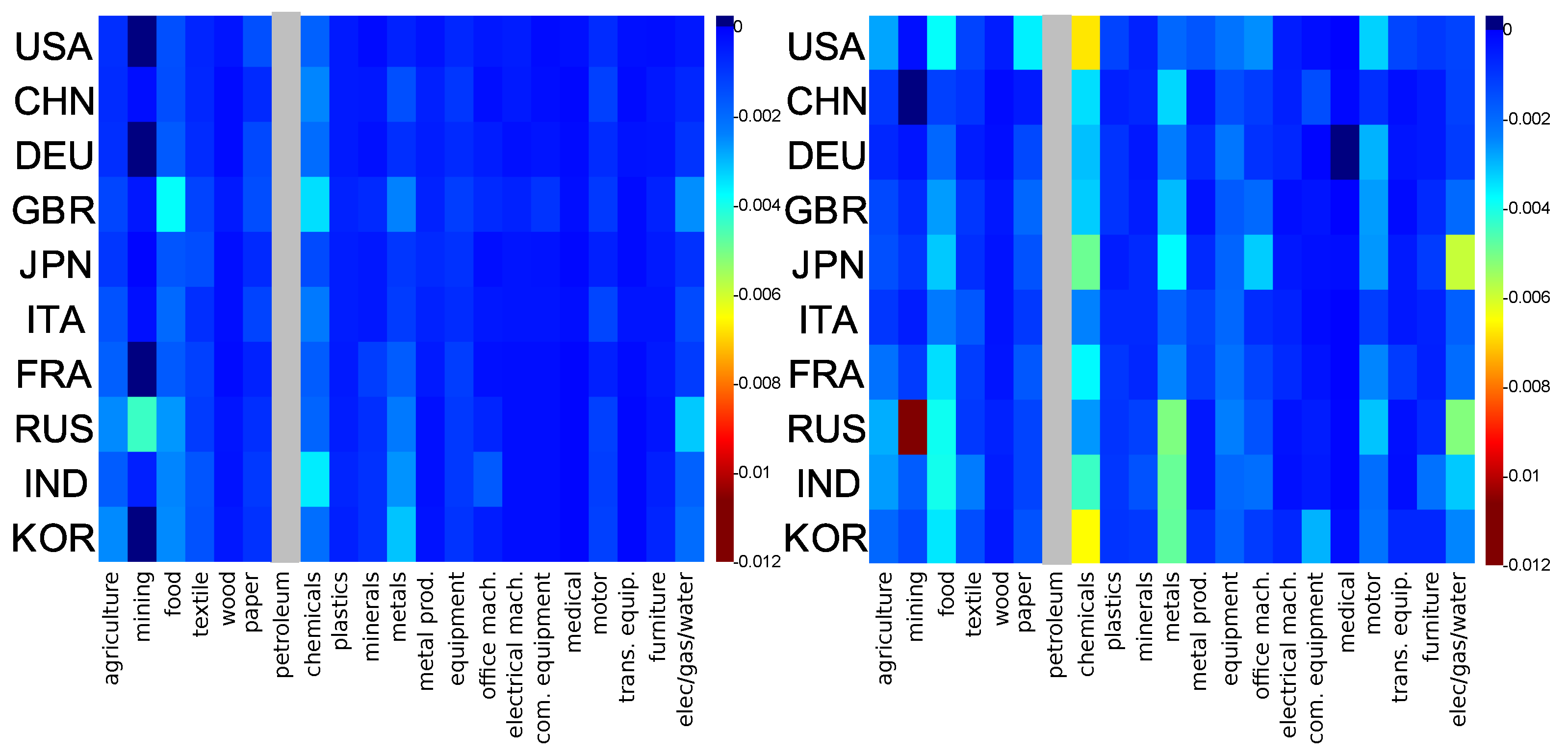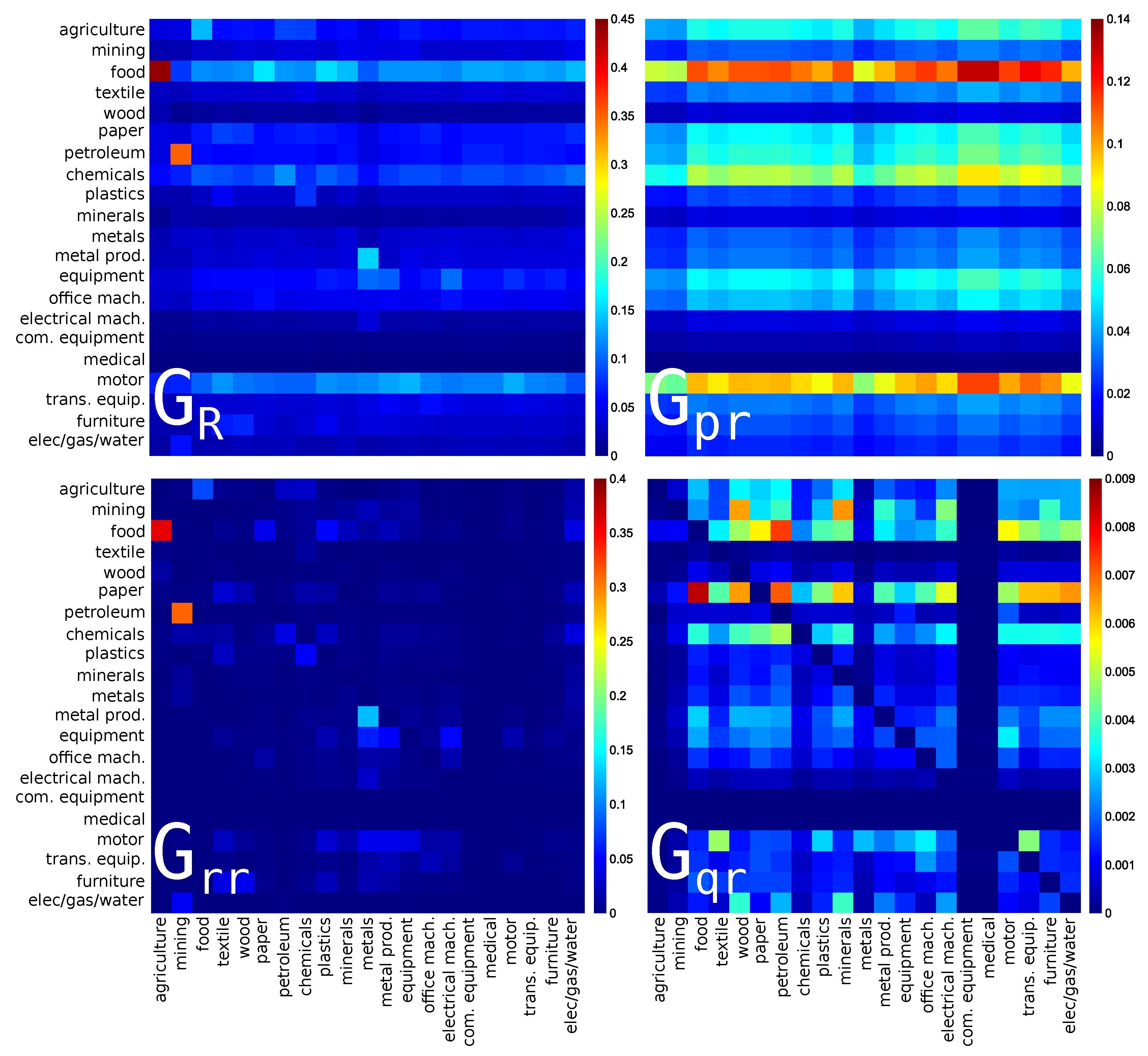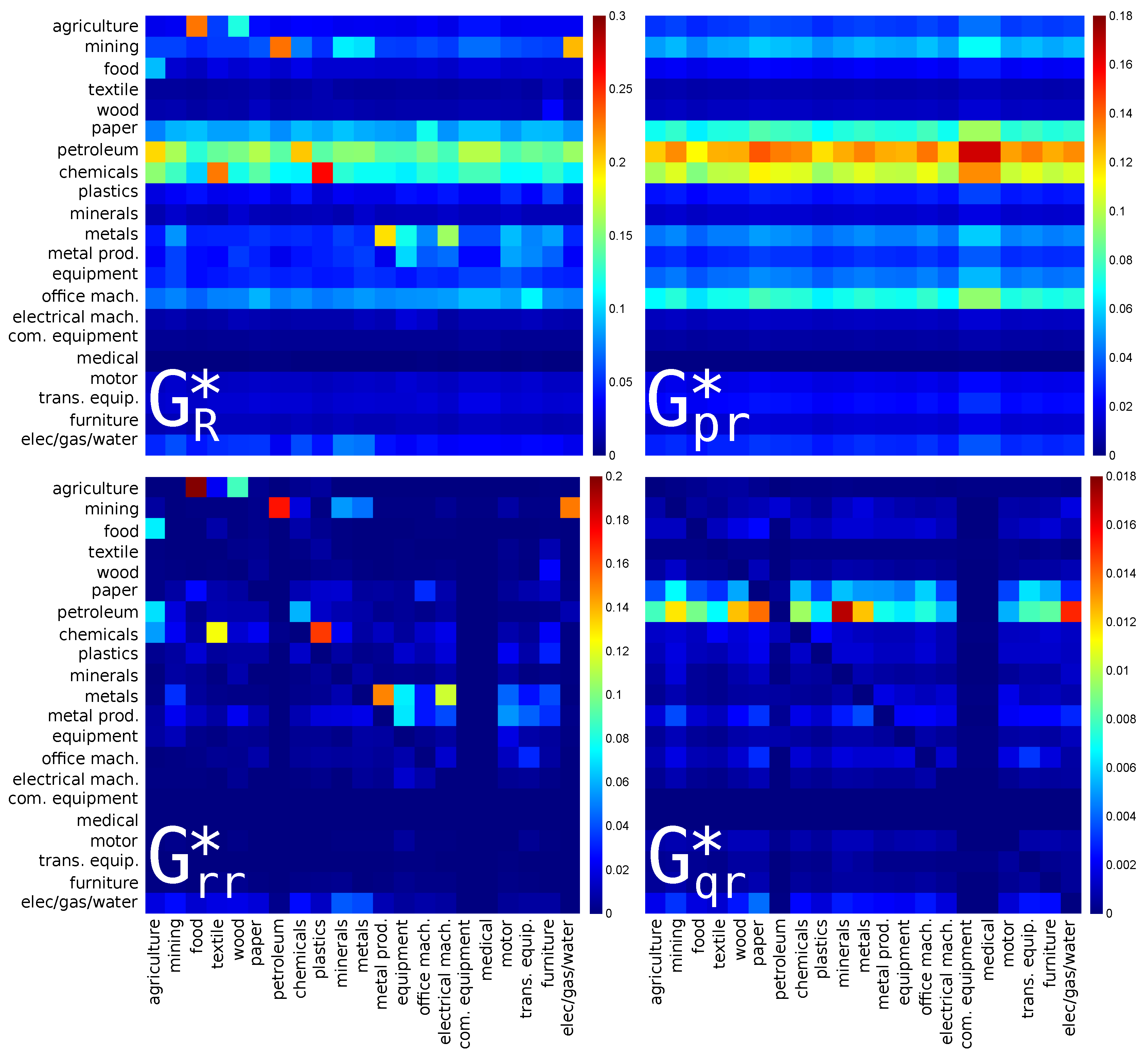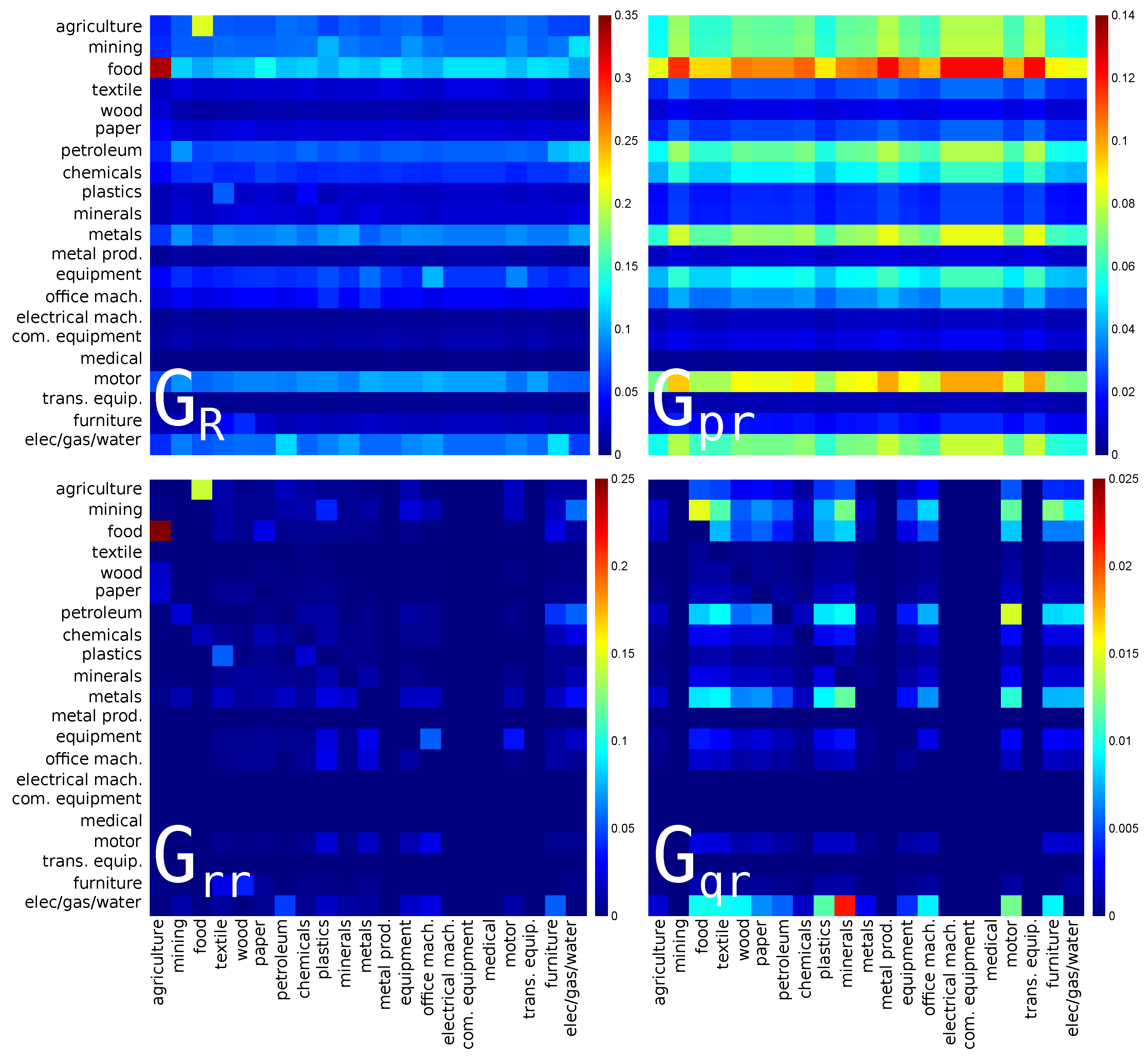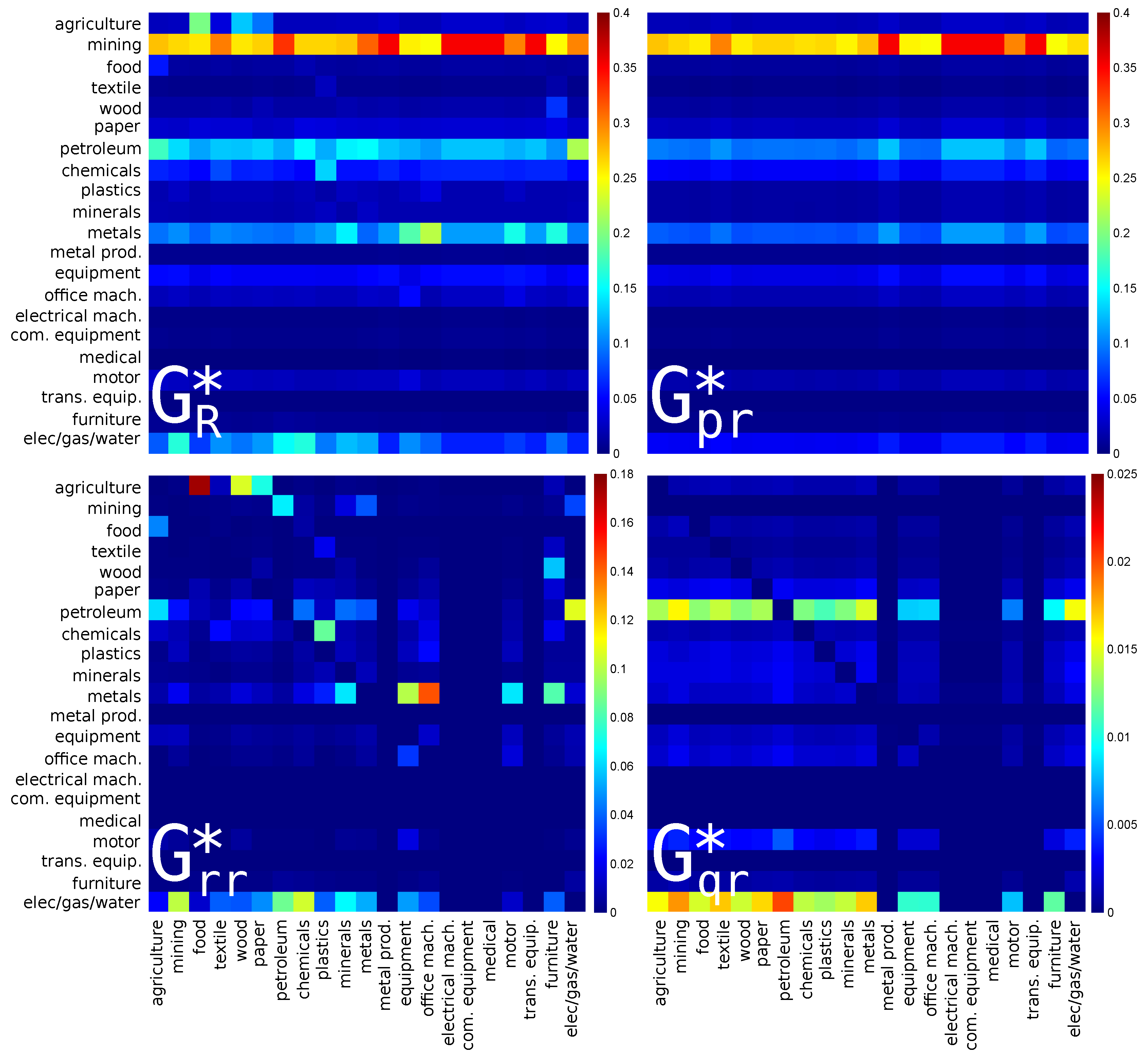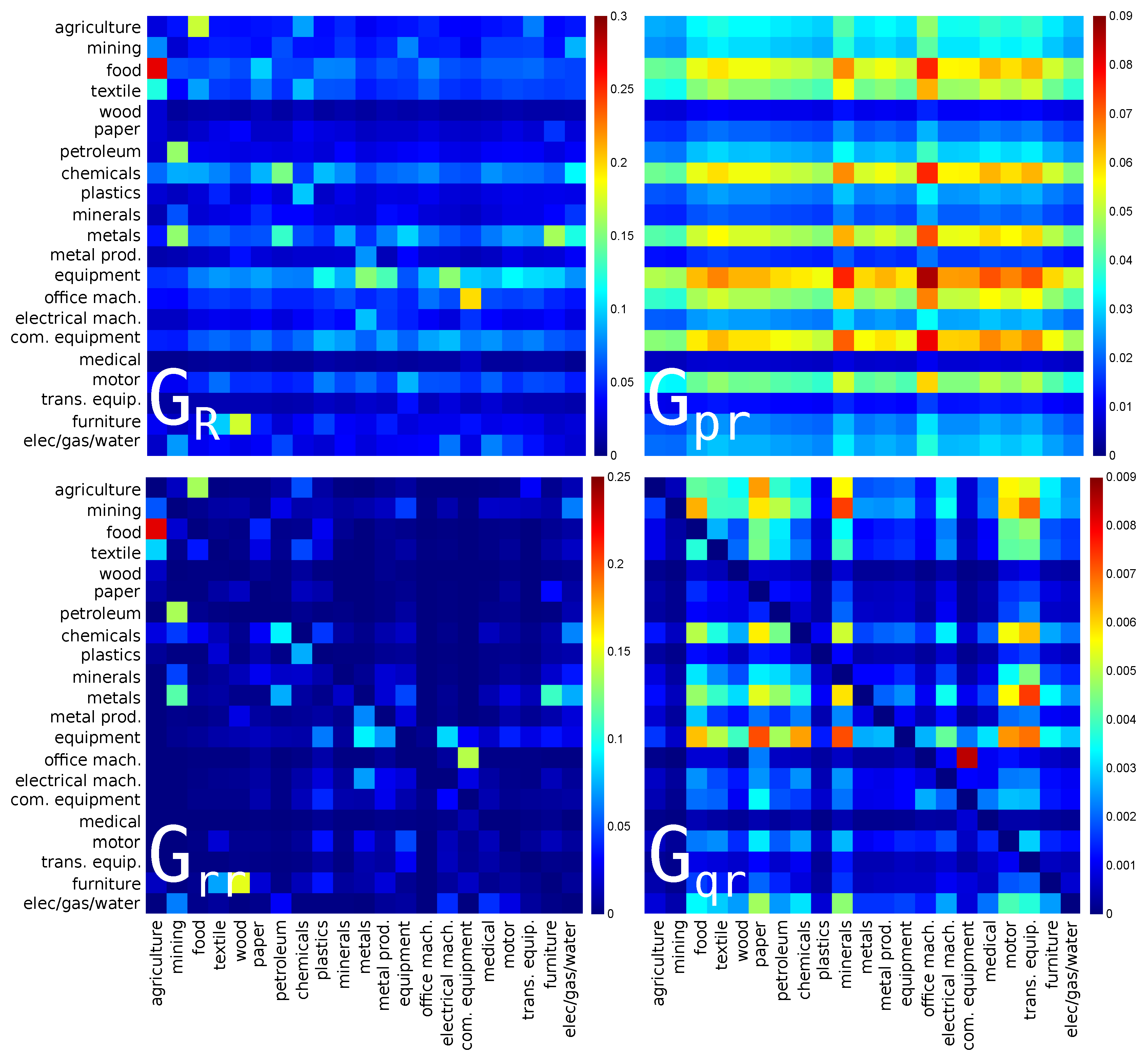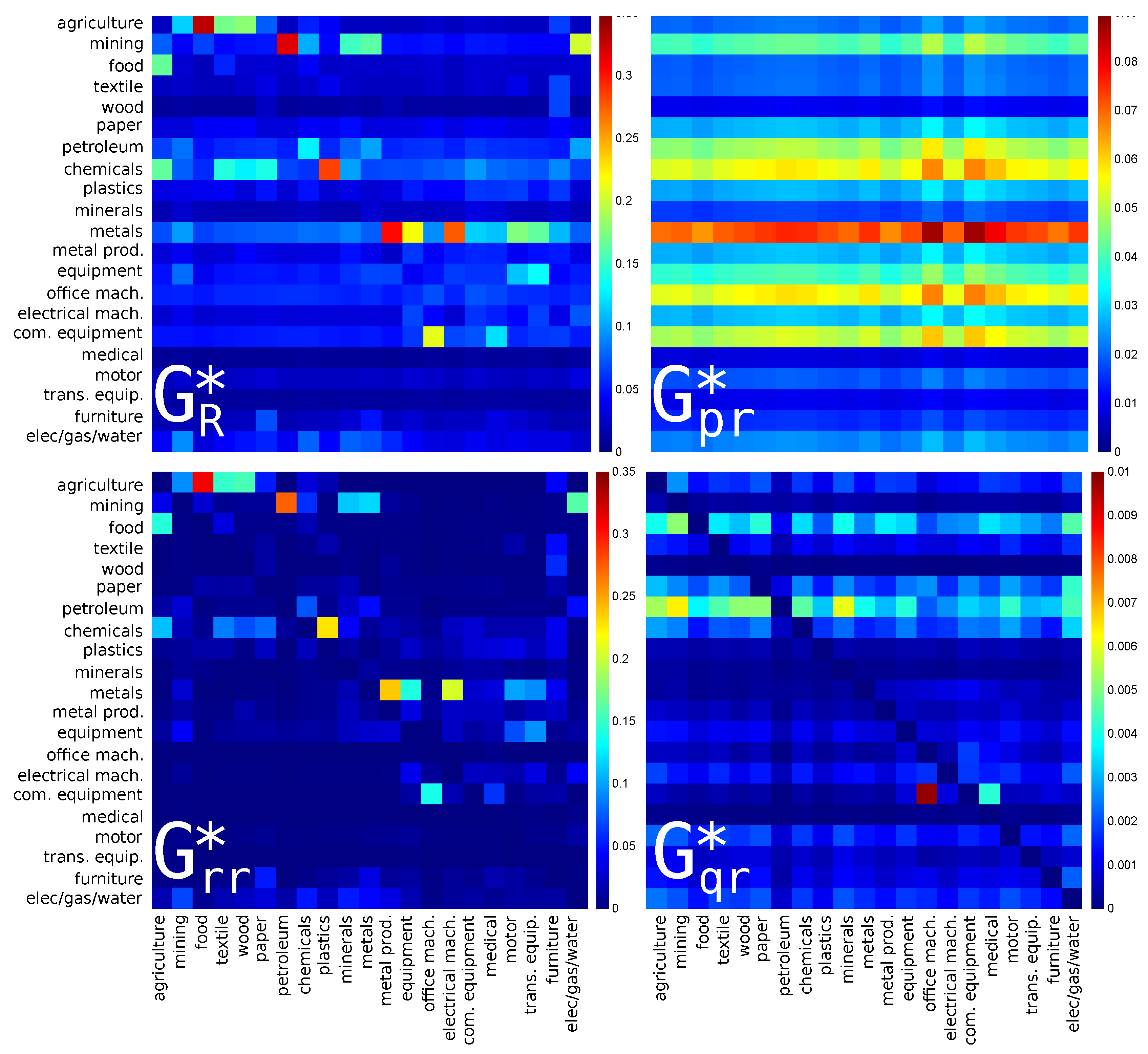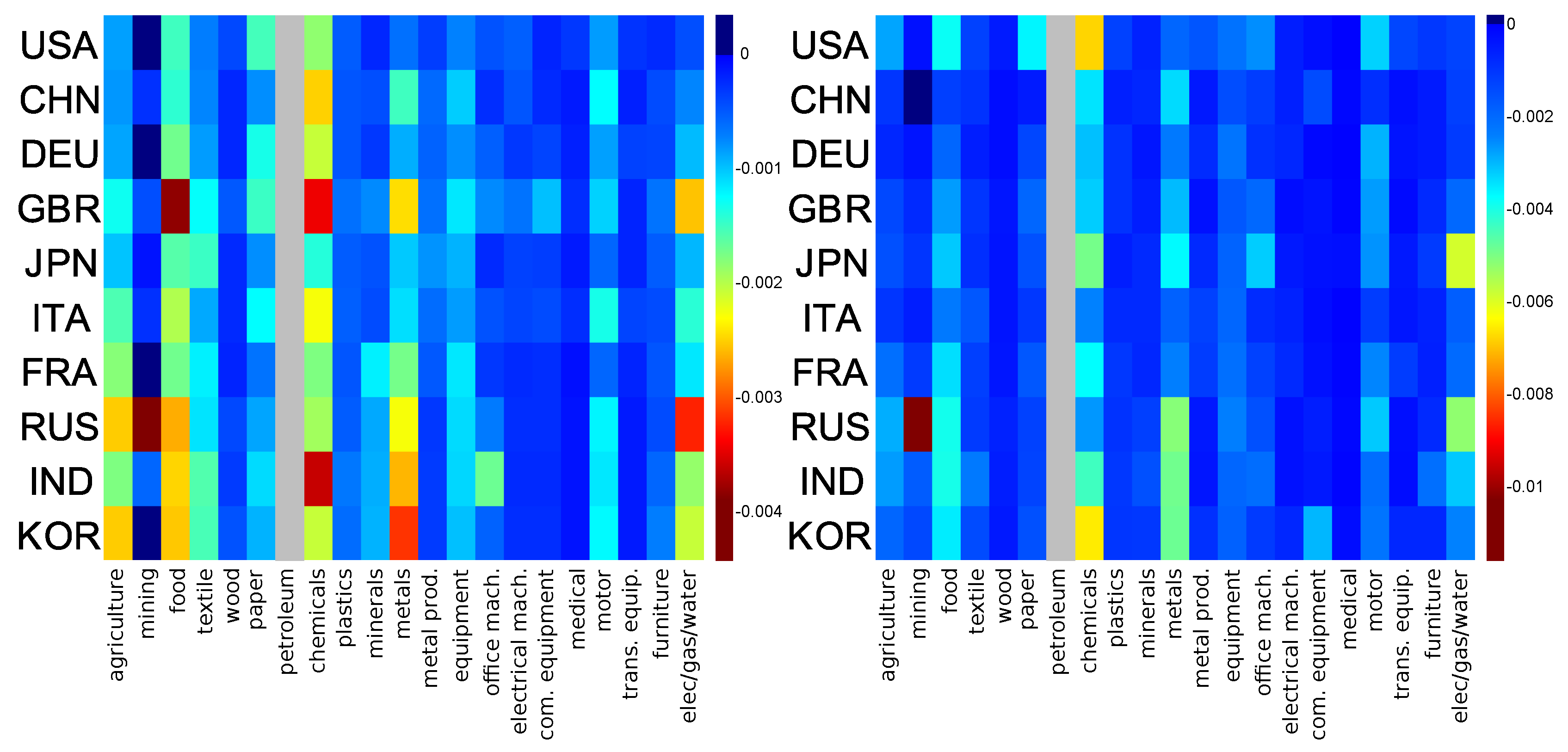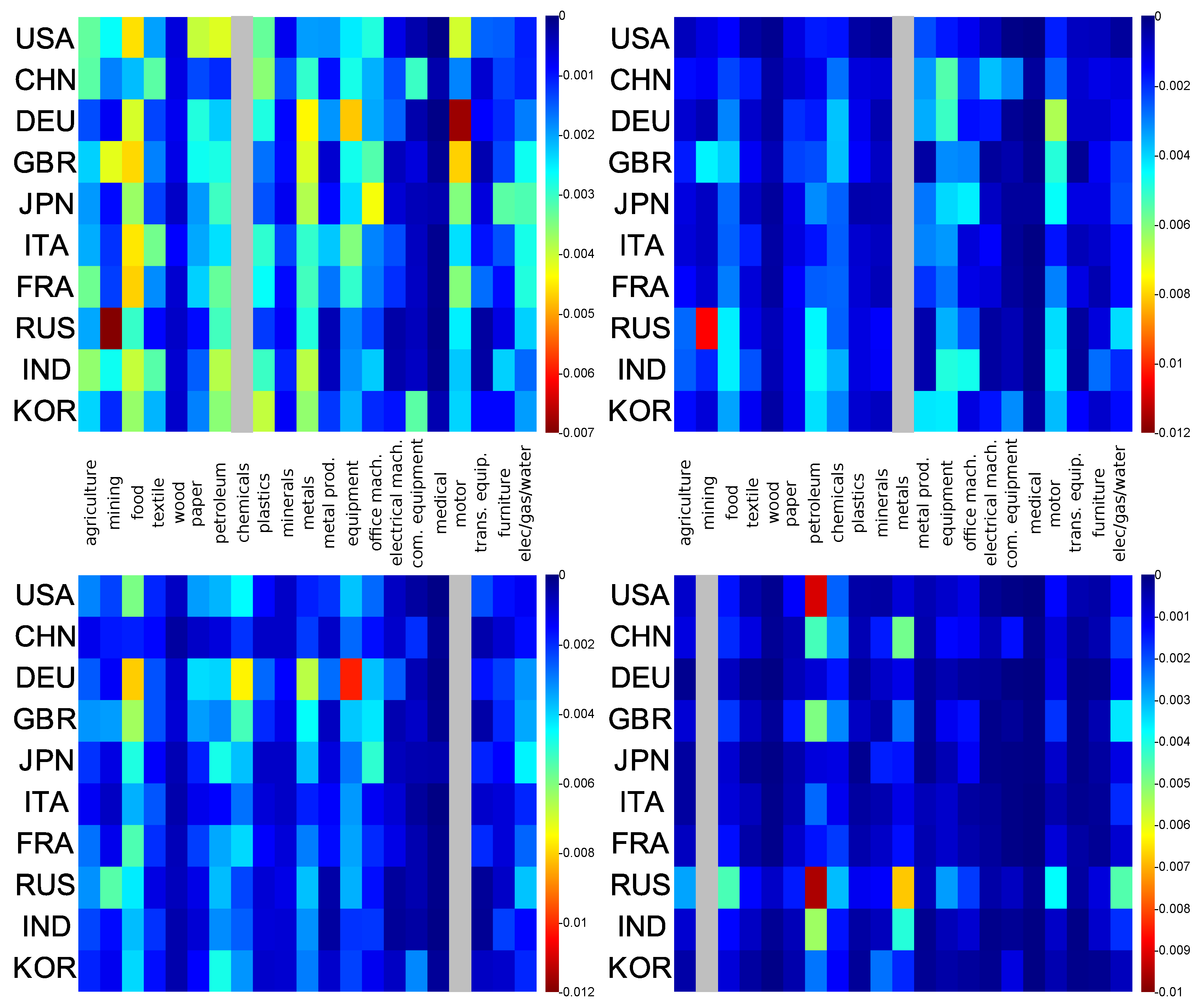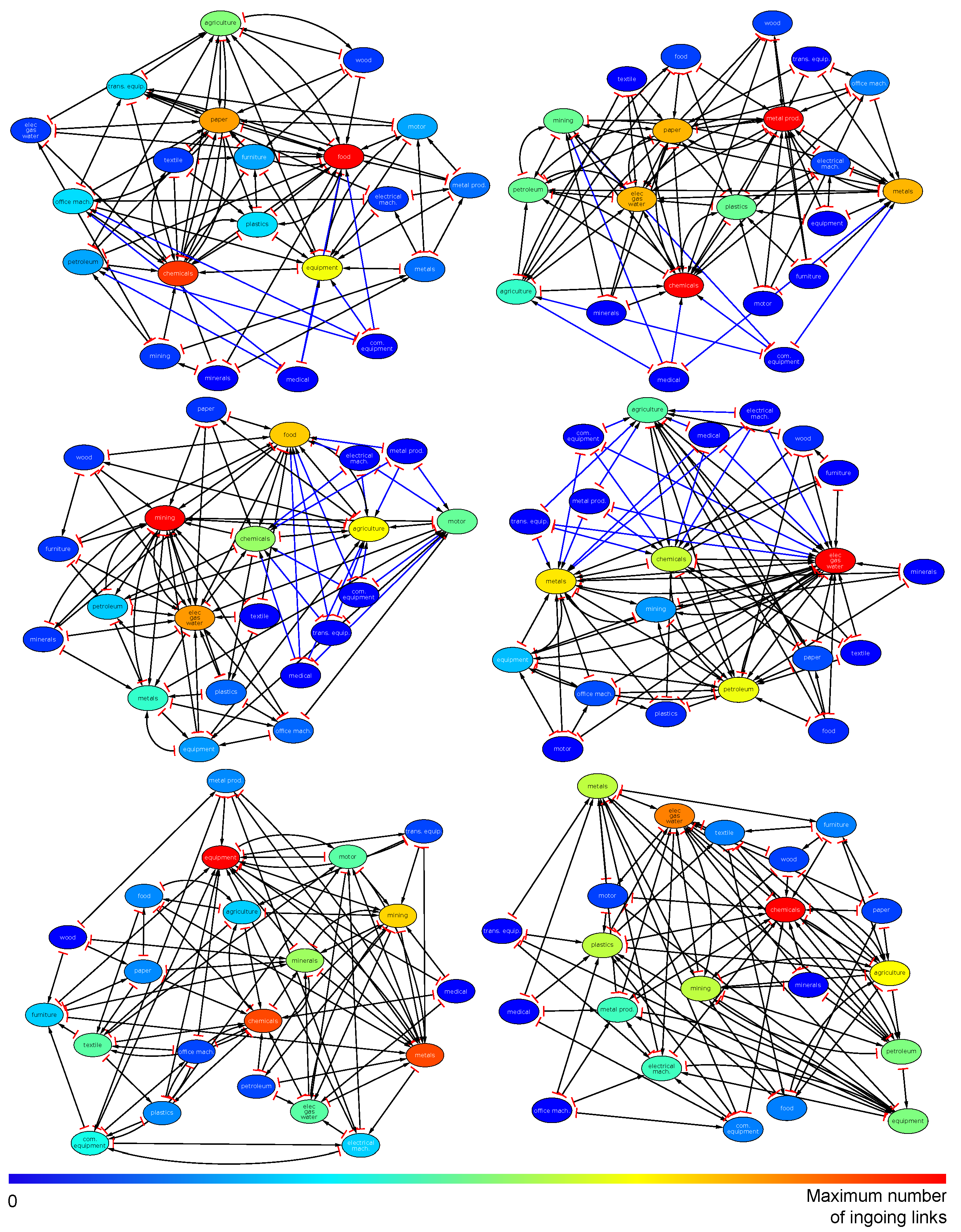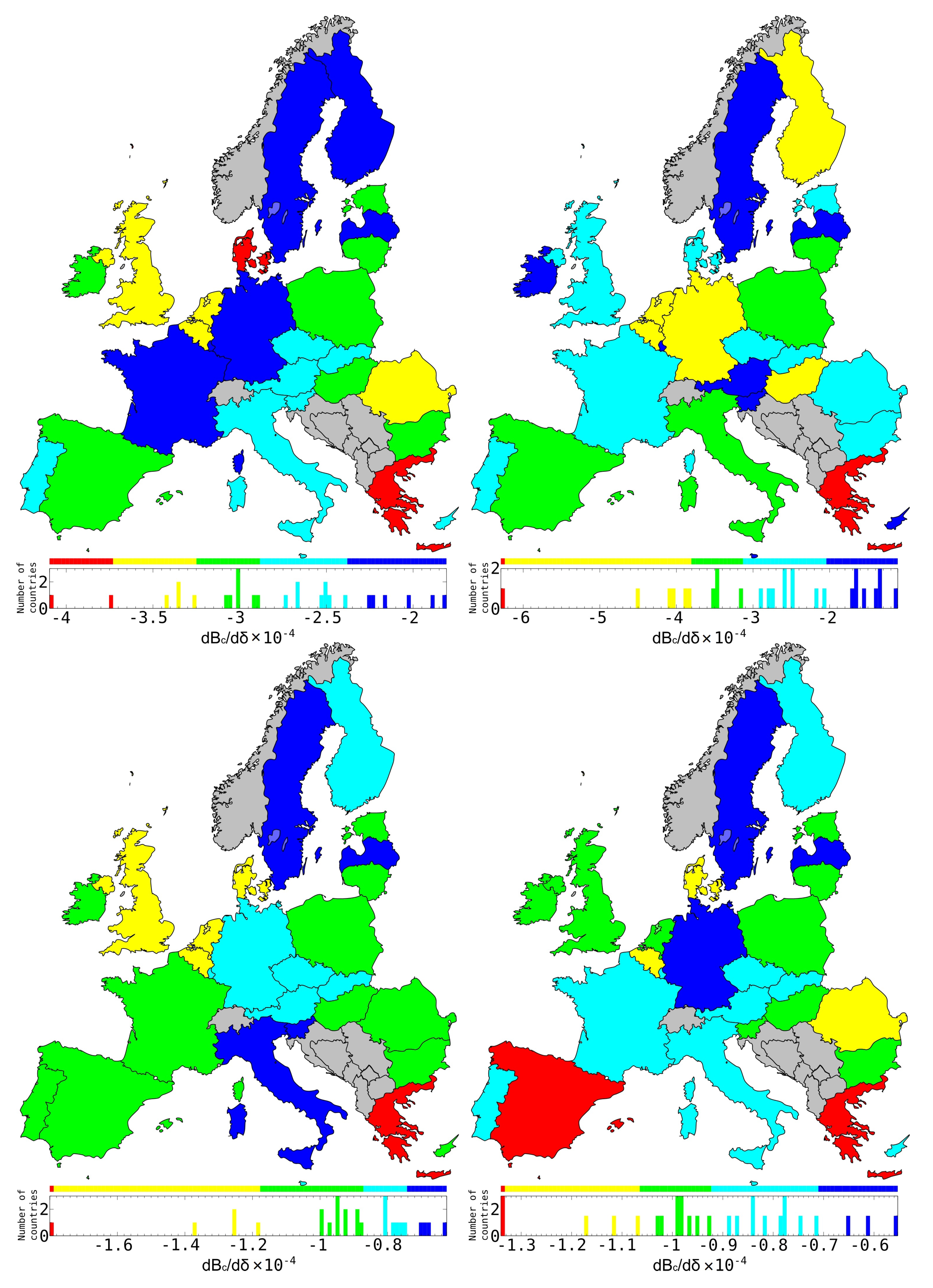1. Introduction
The statistical data of UN COMTRADE [
1] and the World Trade Organization (WTO) Statistical Review 2018 [
2] demonstrate all the complexity of the international trade and the economic relations between world countries. The world economy and the international trade are mutually interacting which makes the analysis of their development very important but also complicated [
3]. Thus, developed advanced mathematical tools are required for the scientific analysis of such complex systems. Usually, their analysis uses the matrix tools of input-output transactions broadly applied in economy and initiated by the fundamental works of Leontief [
4,
5]. More recent developments are described in [
6].
The complex networks constitute a domain of research which emerged in the last two decades alongside with the development of the modern society generating enormous amount of communication including the World Wide Web (WWW), Wikipedia, Facebook, Twitter (see e.g., [
7]). The PageRank algorithm, developed by Brin and Page in 1998 [
8] to retrieve information from the WWW, was at the mathematical foundation of the Google search engine (see e.g., [
9]). This algorithm constructs the Google matrix
G describing Markov chain transitions between the nodes of the WWW network and allows it to rank billions of web pages of the WWW. The efficient applications of the Google matrix analysis to various directed networks have been demonstrated in [
10].
The application of the Google matrix approach to the World Trade Network (WTN) was pushed forward in [
11,
12] using the UN COMTRADE database [
1] which contain information for almost 50 years of world trade. In addition to the PageRank algorithm, it was shown that the analysis of the WTN with the CheiRank algorithm [
13,
14], assuming inverted links, plays also an important role for the study of the world trade. Indeed, the PageRank probabilities of nodes are on average proportional to the number of ingoing links characterizing the import capabilities of the economic actors while the CheiRank probabilities are on average proportional to the number of outgoing links, thus, characterizing export capabilities [
11,
12,
15]. Since both export and import have to be taken into account to correctly describe the world trade, this clearly shows the importance of the combined PageRank-CheiRank analysis. A peculiar feature of the Google matrix approach is the democratic treatment of world countries. They are treated independently of their richness which is different from the usual import and export ranking. The contributions of the various exchanges of products are taken to be proportional to their trade volume.
While the UN COMTRADE database contains an enormous amount of information for all the UN countries with thousands of exchanged products, it records gross flows of commodities and services and consequently counts the value of a product several times as it crosses borders. In the present study, we use the OECD-WTO Trade in Value Added (TiVA) database, which is an Input-Output database, containing net flows of products excluding the contributions of intermediate inputs from upstream industries. The Google matrix analysis of the World Network of Economic Activities (WNEA) constructed from the OECD-WTO TiVA has been reported in [
16]. The approach developed in the OECD-WTO WNEA (2013) incorporates naturally the economic flows between activity sectors [
16] which by construction were absent from the UN COMTRADE based WTN [
11,
12].
Hence, the new important element of the WNEA is the presence of direct interactions between the economical sectors. It is interesting to know what are the differences and the similarities of the economic transfers between the sectors of a specific country taking into account their exchanges with the sectors of the other world countries. To obtain the interactions between sectors of a given country, one should take into account their direct interactions (direct links) but also all the indirect pathways of product transfers throughout the multiplicity of exchanges with the rest of the world. The most appropriate mathematical tool for the extraction of such direct and indirect interactions is the reduced Google matrix algorithm (REGOMAX) [
17]. The efficiency of this approach has been demonstrated in various field such as Wikipedia networks (e.g., interactions between politicians [
18], ranking of and interactions between world universities [
19], interactions between the largest world banks [
20]) and biological networks encoding protein-protein interactions [
21]. Recently, the REGOMAX analysis of the UN COMTRADE database allowed to obtain the influence of the petroleum and the gas trades on the economy of the EU countries [
22]. Here, we use the REGOMAX approach to obtain the interdependence of economic sectors for world countries from the OECD-WTO TiVA database (WTO data) already studied in [
16]. We note that other similar input-output databases exist such as the World Input-Output Database (WIOD) [
23]. In principle, the reduced Google matrix analysis can be also applied to these databases and it would be interesting to probe the similarity of the main conclusions of the present study with the ones we could obtained with, e.g., WIOD.
Previous investigations of the World Trade Network data sets have been realized (see e.g., [
24,
25,
26,
27,
28,
29]), however the main different feature with our approach is the use of the Google matrix methods which characterize both import and export flows taking into account the whole transfer chain between the nodes of the global network. The analysis of both the import and the export directions is rather rare, see e.g., [
30] where the hubs and authorities of the WTN have been studied, but we think that the Google matrix analysis using the PageRank, the CheiRank and the REGOMAX tools characterizes the economical activities in at a deeper and a more detailed level. The matrix analysis of the financial risks already demonstrated its efficiency for undirected flows [
31,
32,
33]. However, the financial and trade flows are directional, and thus, we hope that the Google matrix tools used here will find further useful applications for the study of financial flows and the understanding of economy complexity. The recent studies of directed interbank interactions [
34,
35] indicate possible interesting applications of the Google matrix analysis to the study of financial flows between banks. Recent studies [
36,
37,
38] also measure the PageRank centrality of production networks and Global Value Chains. Here, we go well beyond this sole measure: (1) we take into account the full Google matrix description of the problem as we build two Google matrices. A first one associated to the economical network with the links giving the direction of the flow of goods, and the second one with inverted links. This description allows us to determine a PageRank-CheiRank balance for economical sectors and/or for countries which carries more information than the usual accounting import-export balance [
22] as it takes into account the complexity of the entanglement of countries and economical sectors. (2) Moreover, we apply the REGOMAX algorithm allowing to, for example, extract the direct and the effective indirect links of a given country economical sectors taken into account the complete information embedded in the global network describing the complex exchanges between all the sectorial activities of all the countries.
We suppose that the REGOMAX algorithm, developed from the physical problems of quantum scattering [
17], can become a useful tool for research in the field of econophysics [
39]. We note that the concept of entropy characterizes a possible information amount stored in a system [
40]. In a steady-state (like in a thermal equilibrium), the system is characterized by a certain thermal like distribution when all the information flows inside the system are equilibrated. The Google matrix elements describe the transition probabilities between system’s sites and the information flows between them. The stationary probabilities over the sites are given by the PageRank and the CheiRank vectors. Thus, the Google matrix analysis provides an extension of entropy-type description to network systems.
3. Results
Hereafter, the economical sectors are designated by the short names given in the second column of the
Table 1. For the sake of clarity, these sector short names are printed in boldface.
3.1. Interdependence of the USA Economy Sectors
The reduced Google matrices
and
and their three matrix components for PageRank and CheiRank algorithms with
sectors of USA economy activity (
in
Table 1) are shown in
Figure 1 and
Figure 2 respectively. As shown in [
18,
22], it is useful to characterize each matrix component by their weights
,
,
(and
) corresponding to
,
,
(and
). For each component, the weight is defined as the sum of all the matrix elements divided by the matrix size, i.e.,
. By definition
. For the USA, the matrix weights are given in the captions of
Figure 1 and
Figure 2. For Wikipedia networks (see, e.g., [
18,
19,
20]), one usually has the weights
and
[
18]. Here the situation is more similar to the WTN case [
22] where the weight of
remains rather small while
is by a factor of 3–10 larger than in Wikipedia. As for the WTN [
22], we attribute this to a significantly larger number of links per node in the WTN and WNEA global networks in comparison with Wikipedia networks.
The strongest matrix elements in
show the interdependence of sectors of USA for import or PageRank direction (see
Figure 1). Here, we see the dominance of the interaction from the
agriculture sector (
) to the
food sector (
). Indeed, the agricultural activity produces food used by all the people that makes this link so strong. Another strong link is from
mining (
) to
petroleum (
). Indeed, coke and petroleum are produced by mining and they play an important role in the USA economy. The third link by strength is from
metals (
, manufacture of basic metals) to
metal prod. (
, manufacture of fabricated metal products) that is also very natural. These three links are also well present among direct links in
that corresponds to the importance of direct links in the WNEA discussed above. Interestingly, other links, from
paper (paper and paper product) and from
plastics (rubber and plastics products) to
food, which are not so strong in the direct matrix component
are enhanced in
, illustrating the role of indirect interactions. Indeed, the food products industry uses products of paper and plastic industries for packaging.
Among the matrix components, there are three dominant horizontal lines for food, motor (motor vehicles), and chemicals, which are pointed by the majority of the sectors. These three sectors, which are major sector activities using products of many others, are at the top 3 PageRank positions of USA sectors.
The matrix components highlight hidden links between USA economic sectors. Among the most pronounced hidden interactions in we note that: food is pointing to paper, petroleum is pointing to food and paper. It is clearly understandable that food and paper industries indirectly use petroleum products. Concerning the food to paper link, according to , the food industry directly points to agriculture, and of course the paper industry uses silviculture. This is one of the many possible indirect paths linking food to paper.
For the export or CheiRank direction, the results are shown in
Figure 2. Here, the strongest links are from
plastics (
, manufacture of rubber and plastics products) to
chemicals (
, manufacture of chemicals), from
textile (
, manufacture of textiles) to
chemicals (
), and from
petroleum to
mining. Here again, the dominant contribution is given by
but the strength of the final amplitudes is slightly corrected by
and
contributions which mainly highlight the fact that the petroleum and chemistry industries are the main suppliers of the other economic activity sectors.
The amplitudes of all matrix elements of for the USA, Russia (RUS), and China (CHN) and for the different years are available upon request.
3.2. Interdependence of the Russian Economy Sectors
The reduced Google matrices for Russia for PageRank (import) and CheiRank (export) directions are shown in
Figure 3 and
Figure 4 respectively. They are constructed in the same manner as
Figure 1 and
Figure 2 for USA.
For the reduced Google matrix
of Russian economic sectors with PageRank (import) direction, see
Figure 3, the strongest link is between
agriculture and
food. This is similar to previous depicted case of USA. We note here that the inverted link, i.e., from
food to
agriculture, is weaker but also present in
and in
. This is certainly due to the fact that the food industry also produces products for animal used in agriculture. In
, the most pronounced horizontal line is for
food, highlighting the fact that this industry uses indirectly products of almost all the other economic sectors; it is followed by the line of
motor (
, manufacture of motor vehicles) and
elec/gas/water (
). Among indirect links, the strongest one is from
minerals (
, manufacture of other non-metallic mineral products) to
elec/gas/water.
For the reduced Google matrix
of the Russian economic sectors with CheiRank (export) direction, see
Figure 4, there is the dominance of lines related to
mining, followed, with weaker intensities, by
petroleum,
metals, and
elec/gas/water. This picture is rather different from the USA case in
Figure 2. Although there are only very few weak direct links pointing to
mining, the mining sector is very important since, through the network of exports, it strongly acts (via almost only indirect interactions) upon every sector of the Russian economy. For the hidden links encoded in
, the dominant line is for
elec/gas/water.
3.3. Interdependence of the Chinese Economy Sectors
Interdependencies of the economy sectors of China for PageRank (import) and CheiRank (export) directions are presented with the reduced Google matrix and its components in
Figure 5 and
Figure 6 respectively.
For the reduced Google matrix
, shown in
Figure 5, there are strong links between
agriculture and
food similarly to the USA and Russian cases. In addition, there is a strong transition from
com. equipment (
, manufacture of communication equipment) to
office mach. (
, manufacture of computing machinery). This corresponds to strong Chinese production of TV, computers and other communication related products. In the matrix component
, there are strong lines for
food,
chemicals,
equipment (machinery and equipment), and
com. equipment. We note that, contrary to the USA and Russia, the food sector does not dominate alone as top importer. Indeed, chemistry, communication, computing, and machinery industries also play important roles as they also indirectly use products of many Chinese economic sectors. For the hidden links in the matrix component
, the strongest matrix element points from
com. equipment to
office mach.. Many other links, with a slightly weaker intensity, are also highlighted by the
matrix component, but these are quite weak in comparison with the highest intensities in the reduced Google matrix
.
For the reduced Google matrix
, shown in
Figure 6, the strongest matrix elements are from
food to
agriculture, from
metal prod. to
metals, from
petroleum to
mining, from
plastics to
chemicals, and from
electrical mach. (electrical machinery and apparatus) to
metals. For the
matrix, the strongest horizontal line of transitions is for
metals. Among the indirect matrix elements of
, the strongest link is from
office mach. to
com. equipment.
3.4. Intersensitivity of the Economy Sectors
The above results show specific dependencies between economy sectors for USA, Russia, and China. Here we choose 10 countries (USA, RUS, CHN, DEU, FRA, ITA, GBR, JAP, KOR, IND), for which we determine the balance sensitivity of each economical activity sectors to a price variation of a specific sector. Excepting KOR, these countries are among the top 10 importers according to PageRank algorithm applied to the global Google matrix G. KOR is ranked at the 12th position.
For a given country, the balance sensitivity of a sector
to an infinitesimal increase of sector
s product prices is
. The balance of the economic sector
s is defined as
, see
Section 2.4 for details.
In
Figure 7, we show a map of the balance sensitivity to the
petroleum sector for years 1995 and 2008. The maximal absolute value of the balance sensitivity
D is increased approximately by a factor 3 from 1995 to 2008 showing an increased dependence of economy sectors to petroleum. Partially, this can be attributed to the petroleum price growth from 1995 to 2008 (changed by a factor ∼3, even ∼5 taking April 2008 as reference). For both years and for any of the considered countries, we observe that some economic sectors, such as
electrical mach. (electrical machinery and apparatus),
medical (medical, precision and optical instruments, watches and clocks),
trans. equip. (transport equipment), and
wood, are almost insensitive to the petroleum products sector. Inversely, the most sensitive economic sectors to
petroleum sector are
chemicals,
metals,
elec/gas/water,
food, and (mostly in 1995)
agriculture. Indeed, the activities of these industries directly use petroleum products. For each country, the
mining sector is robust from 1995 to 2008 except for the Russian mining sector for which the balance sensitivity goes from −0.0045 in 1995 to −0.012 in 2008. This is a peculiarity of the Russian mining sector which appears strongly dependent on the Russian petroleum sector. The same data as in
Figure 7 are represented in
Figure A1 (see
Appendix A) but with the same color scale for 1995 and 2008. In
Figure A1, we globally observe that from 1995 to 2008 the
chemicals sector increased its sensitivity to
petroleum sector, by, e.g., a factor ∼3 for USA and KOR. A weaker increase of sensitivity to
petroleum sector could be observed for the
metals and
food sectors. We also observe that Russian and Japanese
elec/gas/water sectors become more sensitive to their national
petroleum sector from 1995 to 2008. From
Figure A1, we additionally note that all the economic sectors of Germany, Italy, and, to a somewhat less extent, of France, Great-Britain, and China remain insensitive to their
petroleum economic sector from 1995 to 2008.
The 2008 sector balance sensitivities to
chemicals,
metals,
motor, and
mining sectors are shown in
Figure 8. Among these economic sectors, the
chemicals sector has the broadest impact on the other economic sectors. The strongest sensitivities to the
chemicals and the
metals sectors concern the Russian
mining and the German
motor sectors. The German economy is the most affected by the
motor sector, particularly the
equipment, the
food, and the
chemicals sectors. The most sensitive economic sectors to the
mining sector are the
petroleum and the
metals sectors, particularly the Russian
petroleum and
metals sectors and the US
petroleum sector.
3.5. Reduced Network of Economic Sectors
We construct the reduced networks of the 21 economic sectors for different countries. For that purpose, we use the import reduced Google matrices
and export reduced Google matrix
corresponding to the USA, Russia, and China economic sectors for 2019. Examples of such reduced Google matrices are presented in
Section 3.1,
Section 3.2 and
Section 3.3 for 2008.
For a given country
c and for the economic sector
s, we select the four links
giving the strongest entries in the composite matrix
(or
) extracted from the reduced Google matrix
(or
) associated to the 21 economic sectors
(see
Figure 1,
Figure 2,
Figure 3,
Figure 4,
Figure 5 and
Figure 6 to have an idea of the composite matrices,
and
, for USA, Russia, and China). The reduced networks constructed from the components of the reduced Google matrix
(
) highlight import (export) capabilities of the economic sectors. Let us note that the compact picture given by the reduced Google matrices at the level of a country comprises in fact the global information encoded in the global Google matrix of all the transactions from any sector
s of a country
c to any sector
of a country
.
In
Figure 9 (top row) we present the reduced network of US economic sectors for import (left panel) and export (right panel) exchanges. From the import point of view, we observe that the
chemicals sector uses products from the broadest variety of US economic sectors as it has the maximum of ingoing links (13 out of 21 economic sector are pointing to the
chemicals sector). Other economic sectors using many US resources are
food (10 out of 21),
paper (10 out of 21),
equipment (9 out of 21), and
agriculture (7 out of 21) sectors. From the export point of view, we observe that the major suppliers of the US economic sectors are (by number of ingoing links)
chemicals (13 out of 21 economic sectors are supplied by
chemicals sector),
metal prod. (13 out of 21),
elec/gas/water (10 out of 21), and
metals (9 out of 21). The
chemicals sector seems to play an important role since it is an economic hub using products of many other economic sectors and being a supplier of many other economic sectors. From both the import and export pictures, we observe that the manufacture of equipment sectors,
com. equipment (radio, television and communication equipment) and
medical (medical, precision and optical instruments, watches and clocks) are linked to other economic sectors only by hidden links, i.e., in WNEA there is no direct commodities exchange between these sectors and the others.
In
Figure 9 (middle row), we present the reduced network of the Russian economic sectors for import (left panel) and export (right panel) exchanges. Here the major importers are the following economic sectors:
mining (18 out of 21),
elec/gas/water (12 out of 21),
food (11 out of 21). We note that the
mining sector uses products of almost all the 21 considered sectors. From the export point of view, the major exporters are the sectors of
elec/gas/water (21 of 21),
metals (13 out of 21),
petroleum (13 out of 21),
chemicals (12 of 21), and
agriculture (9 out of 21). We note that the
elec/gas/water sector, which exploits products of all the other economic sectors, is very central in the Russian economy since it constitutes the major economic hub. From both import and export pictures, as in the US economy, the
medical and
com. equipment sectors are linked to the other by hidden links. In addtion to these sectors, the
electrical mach. (electrical machinery),
metal prod. (fabricated metal products),
trans. equip. (transport equipment) sectors also intervene through hidden links.
In
Figure 9 (bottom row), we present the reduced network of Chinese economic sectors for import (left panel) and export (right panel) exchanges. The major importers are the sectors of
equipment (11 out of 21),
chemicals (10 out of 21),
metals (10 out of 21),and
mining (8 out of 21). The major exporters are the sector of
chemicals (12 out of 21), and
elec/gas/water (10 out of 21). As in the US economy, the
chemicals sector is an economic hub playing a central role in the Chinese economy.
3.6. Sensitivity of the EU Countries to the Petroleum Products Price
The combination of the WNEA data and the REGOMAX approach allow us to study the sensitivity of the country balance to a specific economy sector. In recent studies of the WTN from the EU COMTRADE database [
22], such a sensitivity has been determined for the 27 EU countries (EU members in 2013) in respect to petroleum price variation. Here, for comparison, we show the balance sensitivity of the same 27 EU countries in respect to the price variation of the petroleum. The results are presented in
Figure 10 for the
petroleum sectors of USA, Russia, Norway and Saudi Arabia in 2008. We see that the most sensitive country to US, Russian, and Norwegian petroleum is Greece while the most sensitive to Saudian petroleum are Greece and Spain. Globally, the influence of the USA and Russia are comparable while the influences of Norway and Saudi Arabia (SAU) are by a factor 2–3 smaller.
We note that color maps of the EU balance sensitivities to petroleum products from USA, RUS, and SAU are somewhat different from the one obtained for the WTN case shown in [
22] (
Figure 6 middle row panels). We attribute this difference to the fact that the
petroleum sector contains different petroleum related ISIC products while for the WTN only the petroleum product was considered. In addition, WNEA comprises real inter-sector and inter-country economic exchanges. We nevertheless note that the petroleum sensitivity of Netherlands is in any case moderate to strong as in the WTN study [
22].
In
Figure 10, we observe that Sweden, Finland, and Latvia are the less sensitive to petroleum products of any of the considered suppliers. In addition to these countries, we see that the less sensitive to petroleum products from US are France and Germany, from Russia are Austria, Slovenia and Ireland, from Norway is Italy, and from Saudi Arabia is Germany. In addition to Greece which is the most sensitive country to petroleum products for any of the considered suppliers, the most sensitive are Denmark to US petroleum products, and Spain to Saudian petroleum products.
4. Discussion
In this work, we apply the reduced Google matrix (REGOMAX) analysis to the World Network of Economic Activities (WNEA) data in order to determine the interdependence of the economy activity sectors for several countries with the main accent on USA, Russia, and China. There are similarities and significant differences for the interactions of the economy sectors of the selected countries. All the three countries exhibit strong interdependence between agriculture and food sectors, that is rather natural since all people need agriculture development for food productions, and also between mining and petroleum sectors, that is also very natural. For the US economy, we note that there are also strong interdependence between metals and metal prod. sectors, and between plastics, textile, and chemicals sectors. For the Chinese economy, we observe additional interdependence between com. equipment and office mach., and electrical mach. to metals. From the constructed reduced networks of economic sectors, for each considered economy, we have determined an economic hub which uses a broad variety of products from the other economic sectors and supplies also many of them. For the US economy, the chemicals sector is clearly an economic hub. For the Russian economy, the elec/gas/water sector is central as it is the main exporters to all the other sectors and in return this sector also consumes many resources from the other sectors. For the Chinese economy, as for the US, the chemicals sector is an economic hub. We also determine the sensitivity of the sectors of a given country to the variation of the price of a specific sector. Globally, for any of the top importer countries according to PageRank algorithm applied to the WNEA (USA, RUS, CHN, DEU, FRA, ITA, GBR, JAP, KOR, IND), we observe a strong sensitivity of the chemicals, metals, elec/gas/water, and food sectors to the price increase of the petroleum sector products. Contrarily, the electrical mach., com. equipment, trans. equip., and wood sectors are the most insensitive to the petroleum sector. We compute also the sensitivities of the economic sectors to chemicals, metals, motor, and mining sectors and we determine the color map of the EU countries balance sensitivities to a price increase of products from US, Russian, Norwegian, and Saudian petroleum sectors.
Our study demonstrates that the REGOMAX method allows us to find interdependencies between economy sectors for selected countries. The WNEA data of OECD-WTO contains transformations of production of one sector to another that is absent for multiproduct trade data of COMTRADE. Thus, it would be very desirable to extend OECD-WTO data for more sectors and more recent years. We hope that this will happen in future years.
